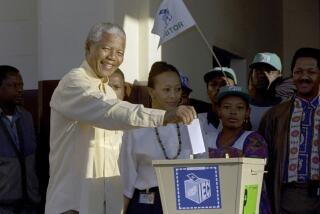Africa’s Last Colony Achieves Its Independence : Namibia: South Africa lowers its flag after 75 years, and a former rebel leader takes over as president.
WINDHOEK, Namibia — South African President Frederik W. de Klerk, ending 75 years of often bloody colonial rule over this desert territory, ordered the lowering of his nation’s flag early today, and the new blue, red and green colors of Namibia were run up the flagpole, establishing the world’s newest nation.
“The independence of Namibia marks the beginning of a new era for the whole of southern Africa,” De Klerk declared before South African soldiers lowered the flag. “We extend a hand of friendship to our new neighbors. May God lead you on a road of peace and prosperity.”
Sam Nujoma, the rebel leader who returned last year after three decades in exile, was sworn in a few minutes after midnight as Namibia’s first president by U.N. Secretary General Javier Perez de Cuellar, who welcomed Namibia as the 160th member of the United Nations.
“The whole world rejoices with you,” Perez de Cuellar said.
An evening of heavy rain showers, always a good omen in African tradition, broke just before the ceremony, and Namibia became independent on a clear, starry morning.
“Africa’s last colony is from this hour liberated,” Nujoma shouted to cheers from the crowd of 20,000 black and white celebrants, some of whom had waited 12 hours in the Windhoek sports stadium to see the ceremony. In a 15-minute inaugural address, the white-bearded new leader also paid tribute to “the tens of thousands of Namibian patriots who lost their lives for this day.”
“Our nation is rising to its feet,” he added. “We are the makers of our own destiny.”
The midnight ceremony, beginning a week of celebrations here, brought together more than 100 heads of state and foreign ministers, some of whom had to squeeze through crowds to find their seats. Among those present were Secretary of State James A. Baker III, Soviet Foreign Minister Eduard A. Shevardnadze and the African National Congress deputy president, Nelson R. Mandela.
The celebrations started early Tuesday in this tidy capital of 100,000, which was bedecked in the republic’s new flag. The main streets of small towns hundreds of miles away were festooned with banners reading: “Our Free Nation--Namibia.” A fresh sense of hope was evident almost everywhere.
“Things may not change for me now, but they will change later on, for my children,” said Joseph Titus, a 23-year-old service station attendant who traveled half a day from the coast to be here for independence.
The new nation is a formidable territory, twice the size of California, that South Africans long considered their own Wild West. Its livable area is sandwiched between the Namib Desert, the world’s oldest, on the Atlantic Ocean and the Kalahari Desert to the east. Most of Namibia’s 1.3 million people, 60% of whom are illiterate, live a simple existence in between these two deserts on semi-arid land ringed by blue mountains.
Namibia’s independence, formally ending a guerrilla war that claimed more than 20,000 lives over 23 years, marked one of the most successful U.N. operations in history. In just under a year, more than 6,000 U.N. police officers, soldiers and civilians supervised the return of 43,000 exiles, a political campaign waged by 10 parties, free elections for a constituent assembly and the writing of a constitution. The U.N. operation cost $500 million.
The new constitution, adopted unanimously by the 72-member assembly, is considered one of the most democratic in Africa. It establishes a multi-party system of government elected by universal franchise, a bill of rights and an independent judiciary.
It also outlaws capital punishment, ends four decades of apartheid by banning racial segregation and calls for its president to be directly elected to a maximum of two five-year terms. (The constituent assembly named Nujoma the first president on the grounds that holding a new election so soon after the last one would be divisive and prohibitively expensive.)
All laws passed by the National Assembly, as the constituent assembly has been renamed, will be subject to review by an upper house, the National Council, a chamber similar to the U.S. Senate, in which each region will have equal representation. Constitutional changes will require a two-thirds majority of both houses.
The majority party is Nujoma’s South-West Africa People’s Organization (SWAPO), a Marxist guerrilla movement that won 57% of the vote in last November’s general elections. Failing to secure the two-thirds necessary to write the constitution on its own, SWAPO ignored much of its socialist ideology and quickly began to compromise with, among others, the pro-capitalist Democratic Turnhalle Alliance, which had won 29% of the vote.
The new constitution has drawn wide support from Namibia’s ethnically diverse population, which includes nearly a dozen black tribes and about 80,000 whites, most of whom are Dutch-descended Afrikaners from South Africa or Germans whose ancestors were the original colonizers.
Namibia faces difficult hurdles in its early days of nationhood.
Although it has substantial mineral resources, including uranium and diamonds, Namibia will remain heavily dependent on South Africa, from which it imports most of its food and other goods.
Namibia’s leaders have adopted a market-oriented economy with no exchange controls in an effort to lure international investment and help offset the expected loss of South African subsidies, which amounted to about half of the annual budget here.
Nujoma’s government is counting on a boom from the lifting of economic sanctions against Namibia. Until independence, Namibia had fallen under the economic umbrella of South Africa, which has been the target of sanctions imposed by the United States, among others.
And Nujoma also has asked the United Nations to lift sanctions against the Atlantic port of Walvis Bay, which remains South African territory but is surrounded by Namibia. Oil and other supplies for Namibia pass through it.
The United Nations first passed a resolution calling for free elections here 12 years ago, but South Africa, which took over the territory from German colonialists in 1915, refused to grant independence and instead installed a governor and later, a multiracial “transitional government,” whose decisions could be overruled by South Africa’s white governor.
More than a decade passed before a complex series of U.S.-mediated peace talks among Angola, South Africa and Cuba ended Namibia’s colonial status. The three countries, under intense pressure from both the United States and the Soviet Union, reached an agreement in December, 1988.
Under that pact, South Africa agreed to grant Namibia independence in exchange for the staged withdrawal of 50,000 Cuban troops from Angola, Namibia’s northern neighbor.
NAMIBIA AT A GLANCE
Population: 1.3 million, mainly black and mixed-race; about 80,000 whites.
Area: 318,000 square miles, the size of California, Oregon and Washington combined.
Languages: Afrikaans, English, German.
Religion: 90% Christian.
Economy: Mining of diamonds, uranium, copper, lead and other minerals; fishing; agriculture.
History: Colonized by Germany in 1884, taken over by South Africa in 1915. Guerrilla war against South African control began in 1966. U.S.-brokered agreement in late 1988 set stage for U.N.-supervised election last November won by guerrilla group SWAPO; constituent assembly fashioned constitution for an independent Namibia.
More to Read
Sign up for Essential California
The most important California stories and recommendations in your inbox every morning.
You may occasionally receive promotional content from the Los Angeles Times.









